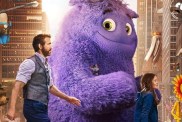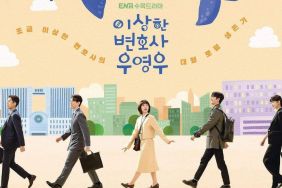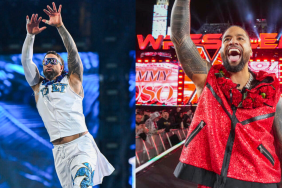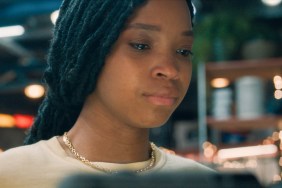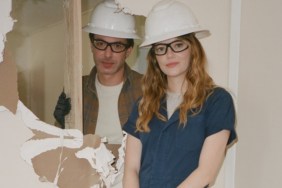When you talk about filmmakers who are legendary and have reached the heights of what can be done with cinema, one of the first names that might come to mind is Martin Scorsese, and the same goes for rock music in terms of the Rolling Stones, who have been making records and touring fairly consistently since their formation in 1962.
The two camps have crossed paths many times, mainly as Stones songs have become the soundtrack to classic scenes in Scorsese’s films, so it was bound to happen that after decades of them working separately they’d eventually come together. In this case, it’s for Shine a Light, a concert film documenting a rare appearance by the Stones in a smaller venue, New York’s Beacon Theater, which Scorsese captured with the help of some of the most acclaimed cinematographers working today, acting as cameramen as they shot two nights at the venue with bulky IMAX cameras.
This past weekend, Scorsese and the four surviving members of the Rolling Stones reunited in New York for a high profile press conference at the New York Palace Hotel. At Scorsese’s last New York press conference for The Departed, he had Leonardo DiCaprio on one side of him and Matt Damon on the other, but this time he was flanked by Mick Jagger and Keith Richards, two of the most well known names, faces and sounds in rock and roll.
Considering how rarely any of the Stones talk to the press, this had all the makings of being a zoo akin to the 2005 Spielberg/Cruise press conference for War of the Worlds with journalists gathering from every possible outlet and medium, as well as TV cameras from every network filming the event. One often has to wonder how much of the circus that surrounds the Rolling Stones wherever they go is self-generated, and yet, this was a surprisingly tame and low-key affair, although the time was far too short and the moderators didn’t let us ask even a single question.
Either way, it was fun being there, livened up by Keith cracking jokes or making his trademark impossible-to-decipher retorts to Mick and Marty’s semi-serious responses. Guitarist Ron Wood didn’t say very much and drummer Charlie Watts said even less.
If you so choose, you can also check out the audio of the press conference by downloading the file here and see some more pictures here.
Mick Jagger: Good afternoon everyone, good afternoon New York!
Question: Mr. Scorsese, could you explain why it was important for you to make this film in a small venue in your native Manhattan? To the members of the band: Mick at one point says “You’ve been a great audience.” I’m sure you’ve said that before, and I’m sure you’ll say it again. Was this audience special? And if so, why?
Martin Scorsese: The importance of making the film on a smaller venue, for me. We discussed doing it at a bigger arena and I looked into that, and actually while I was doing it, I was trying to prepare for that, I began to realize I’d rather? I think I’m better suited to try to capture the group on stage, on a small stage, more for the intimacy then for the group and the way they play together. The way you see the band work together and work each song. I found that to be interesting and more than interesting, it’s just a compulsion of mine. I love to be able to see that and be able to cut from one image to the other, movement, that sort of thing, but really about the intimacy of the group and how they work together.
Jagger: I can’t remember what you said now (laughter) but the audience was a good audience, because I think they really got into the spirit of the movie as well as enjoying being an audience for the band. They were a great audience for the band but also, they were a great audience for the movie.
Keith Richards: They were all cameramen. (laughter)
Scorsese: They enjoyed it, the cameramen liked it.
Question: Keith, did you see anything special about that night?
Richards: The Beacon Theater is special for some reason anyway. It wraps around?especially if you’re going to play there for more than one night and you start to get? the room sort of wraps its arms around you, and every night, it’s warmer. It’s a great feeling room, and also, this band didn’t start off in stadiums (chuckles).
Question: Charlie, do you want to say something about it being a special night?
Charlie Watts: No. (laughter)
Ron Wood: I knew he’d say that.
Question: I understand this is going to be available both on regular screens and also on IMAX and I was wondering how that experience would be different for the fans.
Jagger: It will be very larger (laughter)?
Wood: The slight imperfections might be revealed. (laughter)
Jagger: The funny thing really is that Marty, after looking at all the options, decided that he wanted to make this small, intimate movie and I said, “Well, the laugh is Marty that in the end it’s going to be blown up to this huge IMAX thing, so the intimate moment is shown in IMAX,” but it looks good in IMAX. We’ve got both formats, so we’re happy with that.
Question: For everyone in the band, we’re all impressed with how this movie reminds us of the boundless energy it takes to be on tour. Starting with Mr. Jagger, I’d like to know what vitamins you take and what’s your workout like to do this.
Jagger: God! (laughter) You can forget about that.
Richards: (If we tell you) you’ll all be on it. (laughter)
Jagger: No gym, no vitamins I think that day. Just do it, just get out there and yeah? you get very pressurized in these situations. The thing I always find is when a movie shoot that you really have to come up to the plate and fortunately, we had two nights. As Keith was saying, it’s good to play there more than one night and I agree with him, because the first night we played was more like a rehearsal for us in a way, and by the time the second night came ’round, we got more adjusted to playing in a small theater, because though we played lots of small theaters in the past, we hadn’t done it on this tour, so this was quite different to suddenly go into this small theater. By the second night, we knew how to sort of do it, this was going to be the night with all these people there and everything, but I felt really good about that particular night, so you just have to almost come and do it.
Richards: But it was a turn on.
Jagger: Yeah. (laughs)
Question: Why did you choose Marty as the director?
Jagger: He’s the best one around. (laughs and whoops)
Question: But what would he do that other directors wouldn’t?
Jagger: I can’t answer that but? I’m embarrassed now. He’s not part of the furniture (laughs)? he’s a fantastic director and you assembled a wonderful crew, and I think he would agree with that, and he got fantastic DPs, camera, lighting, everyone working on it, and then very painstaking on the editing to produce the movie that you see. It’s not all in the shooting. It’s obviously in the editing, too.
Richards: Also we didn’t choose Marty, Marty chose us.
Scorsese: It was mutual.
Question: For Marty, with the world of the Mafia being featured in so many of your films, can you make some comparisons to working with the Stones? (laughter)
Scorsese: Uh, well, no, that’s an interesting question. I don’t think I can make any direct associations to it, but the music is something that deals with at times, it reminds me of when I went to see “Three Penny Opera” back in 1959-1960 and how the music affected me and what that was saying and what that play said, and the lyrics were so important to me, that particular play. I found I grew up in an area that was in a sense like the “Three Penny Opera,” and I think at times the Rolling Stones’ music had a similar effect on me. It dealt with aspects of the life that I was growing up around me that I was associated with or saw or was experiencing and trying to make sense of, and so it was tougher, had an edge, beautiful and honest and brutal at times and powerful, and it’s always stayed with me and become a well of inspiration, like to this day. As Mick said in Berlin, he said (to Mick) can I take the line from you? He said, “I want you to know that ‘Shine a Light’ is the only film (of mine) that ‘Gimme Shelter’ is not played in.” (laughter) And when I use “Gimme Shelter” in a film, which I think is just as apropos of the world we’re living in today, “Gimme Shelter.” When I use it in a film, I don’t remember that I used it before. I say, “Well, let’s do that” and they say “Well, Marty you did it before” and I go, “Well, it’s alright.” I keep forgetting, you know, but it’s something that the music has been very important to me over these years.
Question: Which song gave you the most pleasure or was the most important and emotional to you, either when you saw the final film or when you were cutting it?
Scorsese: That’s a hard one, because the entire concert was composed by them as one piece of music in a way?
Question: At the last minute?
Scorsese: Well, we fudged that a bit. (laughs) I mean, it felt like that. It really is impossible to answer, sorry.
Question: For Keith and Mick, which are your favorite films directed by Martin Scorsese?
Jagger: Which one do you like, Keith?
Richards: Oh, me?
Jagger: Marty’s favorite
Richards: Marty’s favorite?
Jagger: “Kundun’s” one of my favorite.
(Scorsese laughs)
Jagger: That’s not a joke. (laughter) Did you do that one?
Scorsese: I did do it, yes (laughter)
Jagger: I love all of them. It’s hard to choose your favorite. I love nearly all of Marty’s movies and I can’t wait for the next one.
Question: You used “Gimme Shelter” in “The Departed” and in other films but you also used “Let It Loose” which is a little bit more obscure song from “Exile on Main Street.” What made you pick that and for your future films will you pick more obscure songs?
Scorsese: Well, for me, I think it’s from “Exile” isn’t it? “Exile on Main Street” is an album I like a lot, and that again is sort of in my DNA so to speak. It just came the way Jack Nicholson sat down next to Leonardo DiCaprio and said, “Do you know who I am?” The tone of that and the mood I found? I heard that sound from that song, and I played it against it. I tried a couple of other things afterwards, because invariably, you say “That’s the first one.. It works but it can’t be (that easy). Working on the first try can’t be that way.” So we tried some other songs, but we went back to “Let It Loose” and placed it just at the right moment in between the dialogue for the highlights of the song, but it had the tone and the mood and again, the edge that the scene had and the characters were like really.
Question: Going back to the set list, a lot of people have called this movie “a meditation on aging.” I was just wondering why you chose a lot of bluesy numbers and a lot of slower songs, but then amp it up at the end. I just wonder why you guys chose the set list like that.
Jagger: I don’t know now. It was 18 months ago. I mean…
Richards: Mick always comes up with the set list because he’s got to sing them. Unless I say suddenly, “Mick, you’ve got ten songs in the same key,” I don’t interfere. We make it up because the man’s got to sing them.
Jagger: Yeah, I think you pick the one you think is best for the night really. I wasn’t thinking, “God, this is a?.”
Richards: There might be a sore throat (and that would be the end of it).
Question: How much are you guys still having fun, and were there moments of that you tried to capture?
Jagger: It took us two days to shoot the picture, but we’ve spent four days doing the premieres and promotions. It’s taken us twice as long doing that. Shooting this movie was quite nerve-wracking in some ways for us, and in other ways it was fantastically enjoyable. I’m sure that Marty has got a lot of things going on, and he’s got to cover it when it happens. It was quite a challenge. Talking about having fun, it was great fun, but it was great challenge for everyone sitting at this platform both on the night and after it. Careerwise, you always see things as great fun, but they’re also challenges to do these things that are slightly different from what you do normally.
Scorsese: For me it was literally the moments when you can see the band working together. All the songs, it’s like a narrative, a story, and the whole sound of the band is like a character, one character in each song. With the grace of these wonderful cinematographers, headed by Bob Richardson, and people like Bob Elswit and Ellen Kuras and Chivo and John Toll, Andrew Lesnie, who did “Lord of the Rings,” Edgar Rollins, they were able to, like poets at times, know exactly when to move that camera to pick up a member of the band. We thought this in 35mm, not video, so we had 10-minute loads, and cameras were going down all the time, running out of film, so another camera would pick up where someone left off. That’s why there were so many, to be able to pick up the slack. But the key was to find the moments between the members of the band and how they work together. It’s like a machine, its own entity during each song.
Question: Who chose the documentary clips and do you think you’ll still perform when you’re 70?
Richards: That’s only five years away. (laughter)
Scorsese: Who chose the clips? Dave Tedeschi’s the editor of the film, and we worked together almost nine to ten months. The music came together rather quickly in the cutting. That was very enjoyable. The hardest part was putting together the clips. I think Dave had over 400 hours of archival footage, and then he chose about 40 hours for me to see, and then we worked from that 40 hours and it was a matter of balancing, saying something but not saying too much and then saying nothing with it. That was the key, and balancing it so it wouldn’t unbalance the music in the piece. To do a film of all archival footage I think would be a four or five hour documentary.
Jagger: There were some moments when I thought the archival footage was going too long and I felt we were going off into another movie and not at a concert. Because it was really kind of riveting sometimes, those old movies, but then if it goes on too long you want to come back to the concert stage. Sometimes David left them a little bit on the long side, so in the end we ended up with what we had, which was good.
Question: Do you have plans to do another acoustic album like “Beggar’s Banquet” in the future?
Jagger: It wasn’t really an acoustic album. It did have acoustic guitar. We don’t, actually, have plans. We do have some acoustic songs in the featurette on the DVD.
Richards: When you can’t afford the electricity, baby, you gotta go acoustic. (laughter)
Question: I loved the version of the Motown classic “Just My Imagination.” Are you guys planning to ever do a tribute album to Motown? And for Marty, how is it shooting back in Boston after “The Departed”?
Jagger: I used to do tributes to Martha and the Vandellas in front of my mirror. (laughter)
Richards: It must have been twenty years ago.
Scorsese: For me, it’s great to be back in Boston. It’s a little cold right now, especially at night, but aside from that it’s really good, and we’re working a little bit outside of Boston, in Medfield and places like that.
Question: You had a number of special guests at the concert including Buddy Guy, so can you talk about your relationship with Buddy Guy? And how you got Jack White to perform with you on “Loving Cup”?
Jagger: In fact, we’ve done quite a few shows with Buddy Guy in the past. I think we’ve known him off and on for quite a long time. He’s one of those continually wonderful blues performers.
Richards: I met him through Muddy Waters, and it goes back a long way.
Jagger: I think that the thing that Marty captured, the duet thing that we did with him, was really one of the high points of the movie for me.
Richards: I didn’t give him that guitar for nothing, then. (laughter)
Jagger: That wasn’t just for show!
Richards: That was a bloody high point to me.
Jagger: Yeah, and I think the other guests all in their own slightly different ways add to the movie. I liked all the duets very much, they really all work. They don’t always work, those duets, but I think everyone likes all the duets, and they really come off, so thanks.
Question: I noticed Al Maysles in a few of the shots. How impacted were you by earlier Stones films like “Gimmer Shelter”?
Scorsese: Al sort of referenced the line of continuity with a number of wonderful films he made with the Rolling Stones, going back of course to “Gimme Shelter” and Hal Ashby’s “Let’s Spend the Night Together” and the Godard.
Richards: Don’t forget “C**ksucker Blues.” (laughter as he smiles knowing that they’re filming this for television)
Scorsese: And “C**ksucker Blues.” But also, the Godard film where you actually see the song “Sympathy for the Devil” come together in the recording studio, which is fascinating. This is a direct reference to the past films, yeah.
Question: Can you talk about the phone call at the beginning where you’re waiting for the set list to be given to you. How real is that tension between you guys in the beginning?
Jagger: Totally real. (laughter)
Scorsese: Absolutely. I trimmed it a bit. The actual phone call was over 45 minutes so I cheated a bit. The idea is to capture the spontaneity of the group, and the word “capture” means you have to control it, but you can’t control spontaneity, so therefore, the cameras have to be in the right position. Then I wanted to go a little further and have them be all moving cameras, but that means they could collide with the performance, so you have to be very careful and all this sort of thing, and also the band is on tour, so basically, we end up talking to each other in like little talking boxes. I shot that at I think 11 o’clock at night on video. I sent my assistant over to the hotel next door, they had white phones. I said “Get me a white phone” because it happened on a white phone. (laughter) I said to David, “Just get the voice in a little speaker, like a box, like the voice of Zeus coming out of the air.” But the humor of that was that we could never really be in the same city together for a long period of time, we just couldn’t do it, and so we had to work that way. I did trim down the phone call, that’s true, although me talking about a camera movement, I couldn’t stop talking about camera moves and sweeps. That’s very real. And the set list itself, it had to really be something that they all worked out almost I think to the last minute. You have to, as he says, know the room. You’ve got to feel the temperature of the audience, you’ve got to feel what’s happening. As he said, it could be softer, it could be anything. I was concerned that we got as much as we could on film because the film is running out of the magazines at 10 minutes a clip. I wanted to get the first three songs completely with all 12 or 15 cameras, whatever it was. But inevitably some of them are going to go out, which happened I think with “She Was Hot.” But luckily we had the backup cameras. I actually found out the set list a little earlier than that. Someone did purloin it. I’m not going to use the word “stolen” or I don’t want to say who it was, but we found it.
Richards: I didn’t realize it was such hard work, Marty.
Question: How did you feel about how Scorsese appearing so much at the beginning and end of the film?
Jagger: We had a lot of trouble working out the ending of the film with Marty because he had to go to a lot of different acting coaches.
Scorsese: It was sad, yeah. I do it in a lot of my pictures, like with Edward Kennedy, the slow burn. He used to go like this (presses hand onto forehead). That’s what it’s like to make films. Another thing is to get into that and literally send up the hapless director, so to speak. Very often you do feel like a hapless person sitting there. It started snowing one night when we were shooting, it wasn’t supposed to snow, things like that. But that’s the nature of what it is. There’s so many concert films now where you see the actual setting up of the concert. Let’s have fun with it, let’s get to the actual tension, and the good humor of that tension, really.
Question: Can you talk about the arc of the film and how that came about?
Scorsese: We hoped for that arc. We need them to perform the way they are, we can’t put cameras in their way, and yet I wanted to get that arc. I knew that getting certain cameramen working together, they could find the angles and find the looks and know when to pan to Ronnie on guitar, know when to pan to Keith, know when to stay on Mick and Charlie, and that sort of thing. I was hoping that the cameras in those positions would get those moments, and then it was constructed in the editing.
Shine a Light will open in select cities, both on conventional and IMAX screens, this Friday, April 4.



